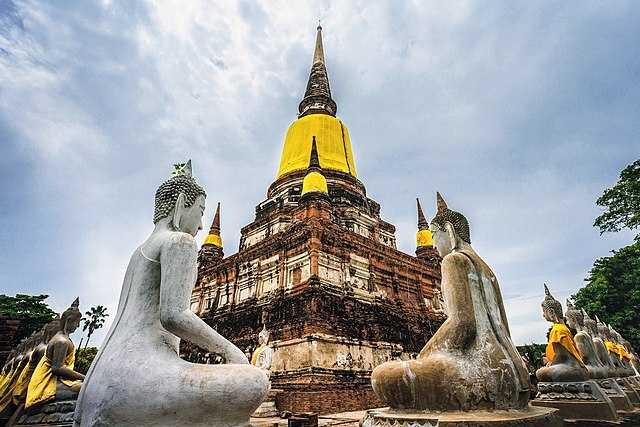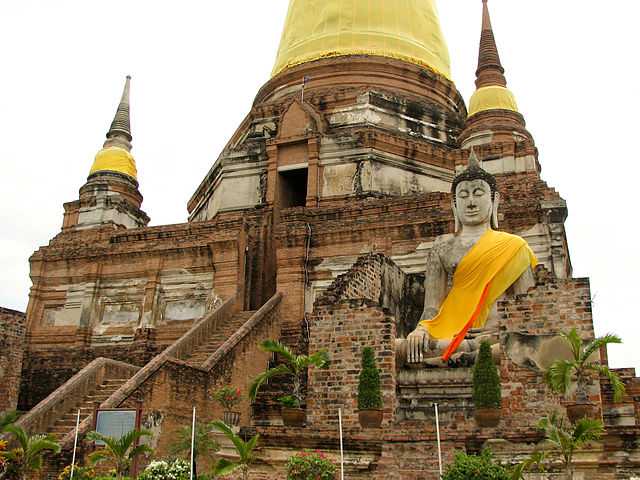Wat Yai Chai Mongkhon
₹ 255 onwards
View Ayutthaya PackagesWeather :
Tags : Buddhist Temple
Timings : 8:00 AM - 5:00 PM
Entry Fee : THB 20
Wat Yai Chai Mongkhon, Ayutthaya Overview
Wat Yai Chai Mongkhon also referred to as the Mongkhon is one of the primary temples in Ayutthaya. This temple has been restored many times since its construction during the 14th century. Although found to be partially ruined, Wat Yai Chai Mongkhon is functioning to date, with several monks housed within the building. It is also possible to view the Thai-style quarters of the monks within its premises today. The local populace also makes sure to worship at the temple regularly, which makes it highly crowded on weekends.
There are numerous folklores and tales of valour associated with Wat Yai Chai Mongkhon. An enormous statue of Buddha in a reclining position attracts the attention of the tourists instantly. Measuring about 23 feet in length, it is positioned outside the temple. The statue has been restored to its present state in 1965 and is visited by thousands of tourists daily. The entire site is surrounded by well-groomed gardens containing manicured lawns as well as multiple Buddha statues of the Lord sitting in meditation. Evidence of a vast moat surrounding the temple indicates it as one of the chief places of worship in the region. Visiting Wat Yai Chai Mongkhon at the close of the day is highly recommended for dusk brings in a play of colours on the ruined remains making it an enchanting sight to behold.
Read More on Wat Yai Chai Mongkhon
History & Significance of Wat Yai Chai Mongkhon

Referred to as the “Monastery of the Auspicious Victory,” Wat Yai Chai Mongkhon was built during the reign of King Rama Thibodi I, also known as King U-Thong, who is believed to be the first ruler of Ayutthaya. The Royal manuscripts that survived the damages of time tell of a tale where the bodies of two of the princes were exhumed and cremated with the “Wat Pa Keo” or the “Monastery of the Crystal Forest” constructed on the site.
A group of monks from Sri Lanka travelled here, later on, to take control of the monastery as the supreme patriarch of the right. Wat Yai Chai Mongkhon changed hands several times in history until it was ruled by King Naresuan who commemorated his victory over the Burmese troop by building an enormous monument of Phra Chedi Chaya Mongkho at the temple. The name of the temple was thus begun to be associated with the auspicious victory.
Architecture of Wat Yai Chai Mongkhon

The architecture of Wat Yai Chai Mongkhon is consistent with the style of the Khmer era and in keeping with the other ruined temples in Ayutthaya. It includes a centrally situated prang known as the Chedi Chai Mongkhon that stands on a raised rostrum. The ordination Hall (ubosot) is found to the east of the prang with the main assembly hall (Viharn) in the west. The smaller chedis, monks’ residences, as well as the minor halls surrounding the main temple, can be viewed to date as well.
_20190322194214.jpg)
The historians have been amazed to discover considerable Burmese influence in the architecture of this particular monastery complex making it apparent that the Burmese had held sway over the region for several years. Visitors are intrigued to find the presence of a couple of pavilions or mandaps that include large images of Buddha. The North Eastern part of Wat Yai Chai Mongkhon is one of the principal areas of the premises on account of the huge statue of reclining Buddha made famous by its open eyes. The statue is also believed to have been constructed by King Naresuanand attracts numerous visitors as well as Buddhist pilgrims.
Dress Code
- Tourists are advised to dress conventionally and keep their shoulders, midriff, arms and legs fully covered within the complex that is a functional place of worship even today.
- Wearing a cap or shielding the eyes with sunglasses within the temple is frowned upon too.
Tips
- It is important to be respectful of all Buddha images and statues. A disrespectful act is a punishable offence regardless of the offender’s nationality
- It is essential to take off the shoes before entering the inner sanctum of the monastery
- Smiling at the monks and treating them with respect is a prerequisite
- Visiting this monastery late in the afternoon is recommended for people eager to capture beautiful photos here
- Carrying a bottle of mineral water and may help one to cope
How To Reach Wat Yai Chai Mongkhon
-
By Car - Many of the tourists prefer to hire a private car for THB 2500 to the temple in Ayutthaya. The vehicle can reach the destination within an hour while travelling from Bangkok. The driver needs to turn south from Wat Sam Plum and take the route No. 3059 to the temple.
-
By Train - You can also take the train from Hualamphong Station in Bangkok to Ayutthaya and then hire tuk-tuks for reaching the ancient temples.
-
By Bus - There are buses available from Bangkok as well as air-conditioned Minivans that reach Ayutthaya in an hour and costs THB 100.
Top Hotel Collections
Top Hotels Near Wat Yai Chai Mongkhon
Wat Yai Chai Mongkhon Reviews

Have a Question on Wat Yai Chai Mongkhon?

experience.